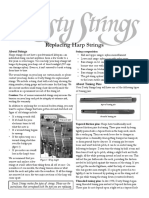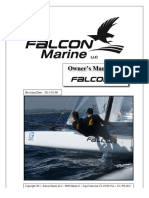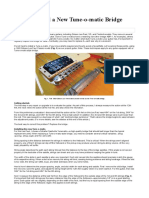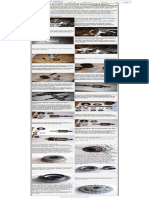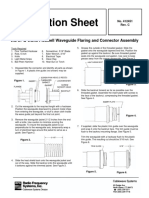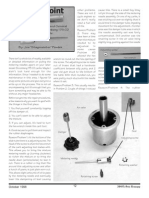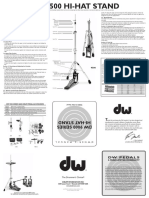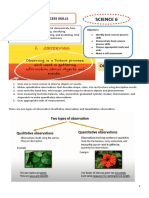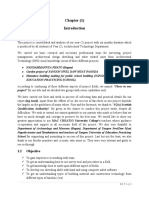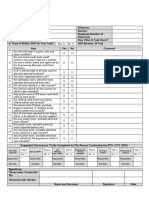Freelander Reverse Repair
Freelander Reverse Repair
Uploaded by
josefzammit15Copyright:
Available Formats
Freelander Reverse Repair
Freelander Reverse Repair
Uploaded by
josefzammit15Copyright
Available Formats
Share this document
Did you find this document useful?
Is this content inappropriate?
Copyright:
Available Formats
Freelander Reverse Repair
Freelander Reverse Repair
Uploaded by
josefzammit15Copyright:
Available Formats
A Case of Mistaken Identity, Part 2
“Impossible?”
By Ed Lee
Before digging into this article, you should first read Wayne Colona’s article, “A Case of Mistaken
Identity,” which appeared in last month’s Transmission Digest. If you didn’t catch it in the March issue,
please take a minute or two and read it before proceeding. What follows will make a lot more sense
once you have read his article.
When filling the front-wheel-drive Jatco 5-speed, it is not difficult for the technician installing the
transmission to mistake the band anchor stud for the fill plug. In fact, as Wayne explained, it’s not dif-
ficult to make this same mistake twice. When you consider that the shortest R&R time is 4.5 hours
on Volkswagen, and the longest R&R time is 9.6 hours on the Freelander, it is important to figure out
a way to rectify this problem without removing the transmission from the vehicle.
Don’t Drive if No Reverse
It is important that you identify the problem immediately. Do not road test the vehicle to check out
the forward speeds if you are having a problem with reverse. The reduction band must be anchored
to the case by the anchor stud to prevent rotation. If you try to drive the vehicle without the stud in
place, the band will rotate, wedging itself between the drum and case. This will prevent the drum
from rotating and will burn the clutches that try to apply for a given gear. If the clutches lose their
service ability, then the transmission must be removed.
First you need to realize what is involved in the process of returning the band to its anchored posi-
tion. The band looks like a shrunken-down version of the forward band in a 4T60-E. When the band
is in its proper position in the case it looks as it is pictured in Figure 1. The anchor stud fits into the
oval hole on one end of the band and
Figure 1 the servo pushes against the other
end of the band for band apply. The
natural spring tension of the band aids
in its release of the drum as the servo
releases its pressure on the band.
The band’s spring tension would make
you think that reinstalling the anchor
stud into the band would be impossi-
ble. The first hurdle you have to over-
come is removing the tension from the
band. This can be accomplished by
removing the cap from the servo cavi-
ty. Once the cap is removed you can
see that the servo release movement
is limited by a snap ring. The servo piston and return spring are located under the snap ring while
the adjusting threads and the adjustment jam nut are located above the snap ring.
Leave the snap ring in place, loosen the jam nut
and back out the servo pin adjustment until about Figure 2
7/8” of threads are exposed. (See Figure 2.) This
will allow you to rotate the band closer to the posi-
tion needed to reinstall the anchor stud. If you have
not backed the adjustment out far enough, you will
still have tension on the band and if you back the
adjustment out too far, the band will rotate past the
servo pin.
At this point, the task still looks impossible. To make
it possible, chuck the anchor stud in a lathe and
drill a hole down the center of the stud. An “R” drill
bit is a good choice for drilling the hole since it is
the tap drill bit for 1/8” pipe threads, and you will
need to plug the hole in the stud when you are finished. Don’t forget to tap the threads into the head
end of the stud before proceeding. You will not want to remove the anchor stud to tap the threads
once you have it back in place.
You’ll need a tool to position the band while reinstalling the anchor stud. The tool shown in Figure 3
was made from .102 music wire, although any number of substitute materials can be used. The two
important things are that the tool be as rigid as possible and have as much of an arch as possible
and still fit down the bore of the stud. The right-angle bend of the tool will help to guide the blind end
of the tool.
If the band is wedged between the drum and the
Figure 3
case, tap it free. Center the band, then rotate the
band until the servo end of the band is resting
against the servo pin. The oval hole in the band will
now be exposed through the anchor stud hole in
the case. Put the band alignment tool through the
center of the anchor stud as shown in Figure 4. The
tool can now be used to position the band as the
anchor stud is installed into the case. When the
anchor stud is successfully installed into the case,
plug the hole in the stud with a 1/8” pipe plug and
adjust the clearance on the band.
In World War II, an Army engineering company had the
motto, “Difficult tasks we do immediately, impossible tasks
take a little longer.” When you’ve successfully replaced
the band anchor stud without removing the transmission
from the vehicle, you’ll surely be able to relate to
those soldiers.
Figure 4
Ed Lee is a Sonnax technical specialist and a member of
the TASC Force (Technical Automotive Specialties
Committee), a group of recognized industry technical specialists, transmission rebuilders and Sonnax
Industries Inc. technicians.
©2005 Sonnax
You might also like
- Sterling Build V2Document16 pagesSterling Build V2Nester Tovar100% (2)
- KYB and Showa Shock ServiceDocument4 pagesKYB and Showa Shock ServiceJose Luis SabinoNo ratings yet
- Single Conductor Re Head InstructionsDocument14 pagesSingle Conductor Re Head Instructionsanksri07No ratings yet
- Pickup Winding Technique Dan Carson PDFDocument5 pagesPickup Winding Technique Dan Carson PDFDeaferrantNo ratings yet
- Silent Partner E-Stringer ManualDocument13 pagesSilent Partner E-Stringer ManualTeresa CarterNo ratings yet
- Chapter 10Document33 pagesChapter 10assaNo ratings yet
- NET-i Viewer Setup - v1.41Document89 pagesNET-i Viewer Setup - v1.41Adeltop4everNo ratings yet
- Quick-Release-Rear-Jaw MORSADocument2 pagesQuick-Release-Rear-Jaw MORSARamon CoelhoNo ratings yet
- Military Mast: Problems and SolutionsDocument3 pagesMilitary Mast: Problems and Solutionsdod3007No ratings yet
- V2 T3PA-Pro Load Cell Installation Manual.: Step OneDocument7 pagesV2 T3PA-Pro Load Cell Installation Manual.: Step OneDriFtOne BrNo ratings yet
- Replacing Harp StringsDocument4 pagesReplacing Harp StringsVictoriaNo ratings yet
- Rigging Manual Club 420 Class: Performance Sailcraft 2000 Inc 2555 Dollard Lasalle, Quebec, H8N 3A9 Tel: 514 363 5050Document11 pagesRigging Manual Club 420 Class: Performance Sailcraft 2000 Inc 2555 Dollard Lasalle, Quebec, H8N 3A9 Tel: 514 363 5050Cesar Arango GomezNo ratings yet
- Atdsm Manual Nl-486Document6 pagesAtdsm Manual Nl-486Bernhard WeberNo ratings yet
- Dusty Strings Guide To Replacing Harp StringsDocument5 pagesDusty Strings Guide To Replacing Harp StringsHeidi DiederichNo ratings yet
- Roadmaster Active Suspension Project - Version2Document7 pagesRoadmaster Active Suspension Project - Version2jbrancacciojrNo ratings yet
- TSR-009 - EngDocument7 pagesTSR-009 - EngA2139No ratings yet
- Dynamo 1Document8 pagesDynamo 1juca leitaoNo ratings yet
- Read Me First!: Resophonic and National Biscuit Installation GuideDocument3 pagesRead Me First!: Resophonic and National Biscuit Installation GuideJohn BrombaNo ratings yet
- Mercruiser Mechanical Trim Actuator Installation - 846063A1Document7 pagesMercruiser Mechanical Trim Actuator Installation - 846063A1JeffNo ratings yet
- Falcon F18 Owners ManualDocument41 pagesFalcon F18 Owners Manualihatemykids643No ratings yet
- 82SSJ SSJ Pulling/Running Tool Operation Manual: Design OverviewDocument3 pages82SSJ SSJ Pulling/Running Tool Operation Manual: Design Overviewsong LiNo ratings yet
- Owner'S Manual and Stringing InstructionsDocument12 pagesOwner'S Manual and Stringing Instructionsralf borgNo ratings yet
- Lead Screw Replacement InstructionsDocument2 pagesLead Screw Replacement Instructions123anthonyNo ratings yet
- Monroe, LA 71203-9573: RR 5, Box 357ADocument2 pagesMonroe, LA 71203-9573: RR 5, Box 357AratheeshNo ratings yet
- 420 Rigging ManualDocument11 pages420 Rigging Manualwindsurferke007No ratings yet
- TalScopes Tal Focuser RebuildDocument2 pagesTalScopes Tal Focuser RebuildNGC 7619No ratings yet
- Safety Precautions: Assembling The CraneDocument1 pageSafety Precautions: Assembling The CraneNotnow CalmNo ratings yet
- 00 - Restringing GuideDocument3 pages00 - Restringing GuideAlain ReiherNo ratings yet
- Pickup Winding Technique Dan CarsonDocument5 pagesPickup Winding Technique Dan CarsonDeaferrantNo ratings yet
- BanjoDocument54 pagesBanjopoisonadn6806No ratings yet
- Carburetor Rebuild 101Part1Document6 pagesCarburetor Rebuild 101Part1thesilverdigsNo ratings yet
- How To Rebuild The Double Cardan JointDocument8 pagesHow To Rebuild The Double Cardan JointAnonymous jm3ZYI6pNo ratings yet
- 11 BookDocument5 pages11 Bookbruno monteiroNo ratings yet
- Model Rocket ConstructionDocument7 pagesModel Rocket ConstructionTushar Tk Vaghasiya100% (1)
- How 2 Install A New Tune-O-Matic BridgeDocument5 pagesHow 2 Install A New Tune-O-Matic BridgeLionello VanoniNo ratings yet
- The Recumbent Bicycle and Human Powered Vehicle Information Center14Document1 pageThe Recumbent Bicycle and Human Powered Vehicle Information Center14Marcel PiersonNo ratings yet
- Pc-Ar 2007Document12 pagesPc-Ar 2007Augusto OrellanaNo ratings yet
- MC-10001 Service SeminarDocument25 pagesMC-10001 Service SeminarAndreiNo ratings yet
- BHManual Wing29 54rev0Document26 pagesBHManual Wing29 54rev0viorelu99No ratings yet
- Replacement Plumb Bobs Manual ME 9868ADocument3 pagesReplacement Plumb Bobs Manual ME 9868A이지민No ratings yet
- Instruction Sheet: WE 37 & WE46 Flexwell Waveguide Flaring and Connector AssemblyDocument2 pagesInstruction Sheet: WE 37 & WE46 Flexwell Waveguide Flaring and Connector AssemblysamiNo ratings yet
- 9827 Equatorial Reflecting Telescope ManualDocument25 pages9827 Equatorial Reflecting Telescope ManualCristi RadutNo ratings yet
- ManualDocument2 pagesManualIsrael AdemolaNo ratings yet
- B.Y.O.C. Wah Kit Instructions For Older Version InstructionsDocument13 pagesB.Y.O.C. Wah Kit Instructions For Older Version InstructionsCavinti LagunaNo ratings yet
- 9 BoltPosiConeRepair30Nov04Document5 pages9 BoltPosiConeRepair30Nov04stefan svenssonNo ratings yet
- Assembling A Can SealerDocument12 pagesAssembling A Can SealerPlantain frankyNo ratings yet
- Type CMR, Instalacion.Document4 pagesType CMR, Instalacion.Mario MarquezNo ratings yet
- Instruction Sheet Is Jf239: - Style Number Jf239Hd:: Package ContentsDocument3 pagesInstruction Sheet Is Jf239: - Style Number Jf239Hd:: Package Contentsdayshift5No ratings yet
- Brooks Trigger Kit 1st Set If InstructionsDocument9 pagesBrooks Trigger Kit 1st Set If Instructionsjimmywiggles100% (3)
- Instrucciones de EnsambladoDocument15 pagesInstrucciones de EnsambladoMetal JiménezNo ratings yet
- 9 BookDocument14 pages9 Bookbruno monteiroNo ratings yet
- Harley Davidson Tech Tips TT09Document5 pagesHarley Davidson Tech Tips TT09brotzabbieNo ratings yet
- M4A2 Wading Stacks Usmc Version: AssemblyDocument4 pagesM4A2 Wading Stacks Usmc Version: AssemblyRobert WallsNo ratings yet
- Swing: Owner'S Manual and Stringing InstructionsDocument12 pagesSwing: Owner'S Manual and Stringing InstructionstopspinlobNo ratings yet
- Instruction Sheet: Flexwell Waveguide Flaring and Connector AssemblyDocument2 pagesInstruction Sheet: Flexwell Waveguide Flaring and Connector AssemblysamiNo ratings yet
- Mark 2 Foucault InstallationDocument16 pagesMark 2 Foucault InstallationmichsNo ratings yet
- Stromberg NeedleDocument2 pagesStromberg Needlevanapeer100% (2)
- DW 9500 ManualDocument2 pagesDW 9500 ManualCesarNo ratings yet
- InstmanDocument2 pagesInstmanSandeep SNo ratings yet
- Anchoring, Mooring and Towing PDFDocument16 pagesAnchoring, Mooring and Towing PDFkullanici2010No ratings yet
- Metalwork and Machining Hints and Tips for Home Machinists: 101 Plans and DrawingsFrom EverandMetalwork and Machining Hints and Tips for Home Machinists: 101 Plans and DrawingsNo ratings yet
- WorkShop Syllabus - IIDocument6 pagesWorkShop Syllabus - IIUbaid BahussainNo ratings yet
- Sort Set-In-Order Shine Standardize Sustain: What Is 5-S?Document43 pagesSort Set-In-Order Shine Standardize Sustain: What Is 5-S?Navnath TamhaneNo ratings yet
- Exercises Materials and ToolsDocument4 pagesExercises Materials and ToolsGabi Neagu100% (1)
- First Quarterly Exam in Tle 8Document4 pagesFirst Quarterly Exam in Tle 8janine abelNo ratings yet
- Science 6 ModuleDocument6 pagesScience 6 ModulezaiiNo ratings yet
- Heavy Equipment Servicing (Mechanical) NC IIDocument63 pagesHeavy Equipment Servicing (Mechanical) NC IIMichael Cancho100% (3)
- CHAPTER X FooT Impression and Tool ImpressionDocument2 pagesCHAPTER X FooT Impression and Tool ImpressionjenerigracemNo ratings yet
- Vocabulario Tecnico de HerramientasDocument8 pagesVocabulario Tecnico de HerramientasEMMANUEL MARTINEZ BUENONo ratings yet
- Lesson Plan in CHS 10 HandtoolsDocument3 pagesLesson Plan in CHS 10 HandtoolsRonnel SingsonNo ratings yet
- Semi-Detailed Lesson Plan: Preparing Construction Materials and ToolsDocument7 pagesSemi-Detailed Lesson Plan: Preparing Construction Materials and ToolsJhanrey Carreon100% (1)
- Bicol Merchant Marine College Inc., Brgy. Piot, Sorsogon City AY: 2020Document9 pagesBicol Merchant Marine College Inc., Brgy. Piot, Sorsogon City AY: 2020Vaya Dichoso AceitadoNo ratings yet
- 3 in 1 Project (Bagan Project)Document23 pages3 in 1 Project (Bagan Project)sawkaykhinemgNo ratings yet
- Tools in Plant PropagationDocument7 pagesTools in Plant PropagationRMG REPAIR67% (3)
- Classifies Tools and Materials According To Their Use (Measuring, Cutting, Sewing) TLE6HEDocument9 pagesClassifies Tools and Materials According To Their Use (Measuring, Cutting, Sewing) TLE6HEAbeguil Lipranon100% (2)
- Tle 9 Q2 - E5 - SLMDocument4 pagesTle 9 Q2 - E5 - SLMCaryll BaylonNo ratings yet
- K To 12 Basic Education Curriculum Junior High School Technical Livelihood Education and Senior High SchoolDocument2 pagesK To 12 Basic Education Curriculum Junior High School Technical Livelihood Education and Senior High SchoolHazel Divino - MirandaNo ratings yet
- K To 12 Carpentry Learning ModulesDocument118 pagesK To 12 Carpentry Learning ModulesJerusJirehMayor88% (8)
- Tle Eim Week 5Document7 pagesTle Eim Week 5Daniel SampagaNo ratings yet
- Bombas SumergiblesDocument79 pagesBombas SumergiblesInstinct_brNo ratings yet
- 01.06.2021 Method Statement of Construction of CellarDocument7 pages01.06.2021 Method Statement of Construction of CellarPangky AbasoloNo ratings yet
- Eirich Intensive Mixer PDFDocument2 pagesEirich Intensive Mixer PDFabrahymyrfan3No ratings yet
- Hand Tools Injury Prevention: DR Zehari DR Wahid TPC Hse TeamDocument23 pagesHand Tools Injury Prevention: DR Zehari DR Wahid TPC Hse TeamArshad MahmoodNo ratings yet
- A Reseacher Project Proposal Presented To: Development of Inovative Animation LightboxDocument28 pagesA Reseacher Project Proposal Presented To: Development of Inovative Animation LightboxAnonymous PnMjaxGZPwNo ratings yet
- Civil Technology 1: Anthony D. Lumanlan, Maed, LPTDocument55 pagesCivil Technology 1: Anthony D. Lumanlan, Maed, LPTAr-Ar CruzNo ratings yet
- Homebrew EquipmentDocument5 pagesHomebrew EquipmentCaio Augusto Santos CastroNo ratings yet
- Hand ToolsDocument1 pageHand ToolsMackson NkhomaNo ratings yet
- Toaru Majutsu No Index New Testament - Volume 02Document150 pagesToaru Majutsu No Index New Testament - Volume 02Geogeneral100% (1)
- Carpentry LessonDocument118 pagesCarpentry LessonJessica RebodosNo ratings yet










